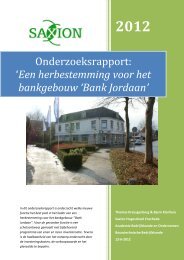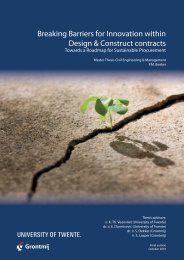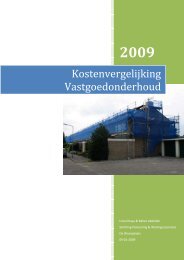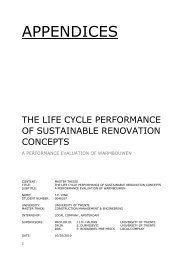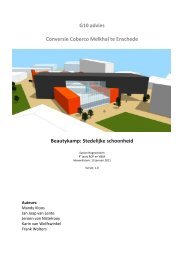the life cycle performance of sustainable renovation concepts
the life cycle performance of sustainable renovation concepts
the life cycle performance of sustainable renovation concepts
- No tags were found...
Create successful ePaper yourself
Turn your PDF publications into a flip-book with our unique Google optimized e-Paper software.
Central GovernmentProvinceGovernmental water agencyMunicipalityProsperity agencyLandownerDirect local residentsO<strong>the</strong>r involved residentsFuture userProject developerArchitectContractorConstructorConsultantsFinancial consultantEnvironmental organizationsSubsidy distributorThe stakeholders in a <strong>renovation</strong> project are considered to be <strong>the</strong> same as <strong>the</strong>stakeholders in a new development project. The list above describes <strong>the</strong> possiblestakeholders in a <strong>renovation</strong> project. Appendix V describes <strong>the</strong> role and <strong>the</strong> requiredfocus <strong>of</strong> involved stakeholders in a <strong>renovation</strong> project for <strong>the</strong> implementation <strong>of</strong><strong>sustainable</strong> <strong>renovation</strong> applications.PROCESSRenovation <strong>of</strong> <strong>the</strong> current built environment has a high potential in <strong>the</strong> field <strong>of</strong> energysaving and CO 2 reduction. However, <strong>the</strong> integration <strong>of</strong> energy- and sustainability aspectsin <strong>the</strong> current built environment is not applied as frequently as desired. Experiences from<strong>the</strong> Dutch government point out that integration <strong>of</strong> sustainability aspects in <strong>the</strong> earlyphases <strong>of</strong> a <strong>renovation</strong> process can be advantageous for <strong>the</strong> implementation <strong>of</strong> <strong>the</strong>seaspects (Hoppe, 2009). Apparently, <strong>the</strong> process has an influence on <strong>the</strong> amount <strong>of</strong>innovative <strong>sustainable</strong> measures that are applied.This subparagraph compares <strong>the</strong> conventional <strong>renovation</strong> process with a process that isrequired for <strong>the</strong> successful execution <strong>of</strong> innovative projects. For this comparison, insightsfrom <strong>the</strong> case “De Tempel” and insights from experts interviews results in conclusionsabout <strong>the</strong> process that is most suitable for a „WarmBouwen <strong>renovation</strong> project‟.CONVENTIONAL RENOVATION PROCESSPHASESTenderProgramDesignConstructionAfter concerns / use /maintentancePROCESSESSubscriptionDialogueSelection <strong>of</strong> partiesInitiativeFeasibilityProject definitionSpatial programPreliminary DesignDefinitive DesignTechnical DesignDrawingsPrice and forming contractConstruction DesignConstruction -ManagementCompletionUsage/garantuee/ afterconcernsUsage / MaintenanceRenovation /redevelopmentDemolishFIGURE 13-TRADITIONAL RENOVATIONPROCESS (POEL, HUTJES & TIEKSTRA,2007)In <strong>the</strong> report “Innovatieve totstandkomingsprocessen inde woningbouw”, Poel, Hutjes & Tiekstra (2007)describe <strong>the</strong> traditional <strong>renovation</strong> process as known in<strong>the</strong> Ne<strong>the</strong>rlands. Figure 13 provides a graphicaloverview <strong>of</strong> this process.Poel, Hutjes & Tiekstra (2007) describe that <strong>the</strong>traditional <strong>renovation</strong> process leads towards problemsfor <strong>the</strong> integration <strong>of</strong> sustainability measures into adesign. Especially in <strong>the</strong> design process, <strong>the</strong> aspectenergy and sustainability is considered to be notimportant enough. As a result, this aspect is not takeninto account in an early phase. The consultant thatattends to interests from sustainability point <strong>of</strong> viewgets involved in a later phase. In practice this leads to aseparation between <strong>the</strong> constructive and architecturaldesign, and <strong>the</strong> design <strong>of</strong> <strong>the</strong> installations. Especially for<strong>renovation</strong>s it accounts that <strong>the</strong> long term strategicpolicy is not given enough attention. As a result,aspects as comfort, air quality, and sensation <strong>of</strong> <strong>the</strong>house are not important enough during <strong>the</strong> process.Also <strong>the</strong> changes in process phases lead towardsefficiency losses. The separation <strong>of</strong> disciplines andphases also lead towards a separation in expertise.Therefore, involved parties as <strong>the</strong> architect and <strong>the</strong>28





